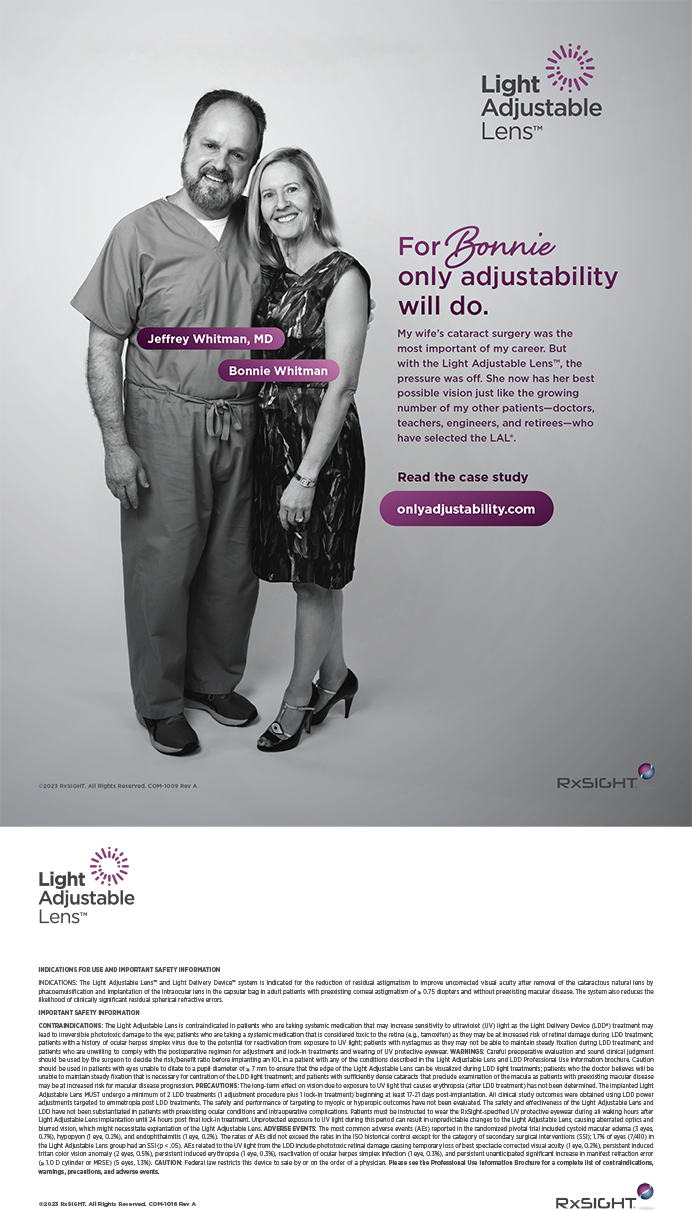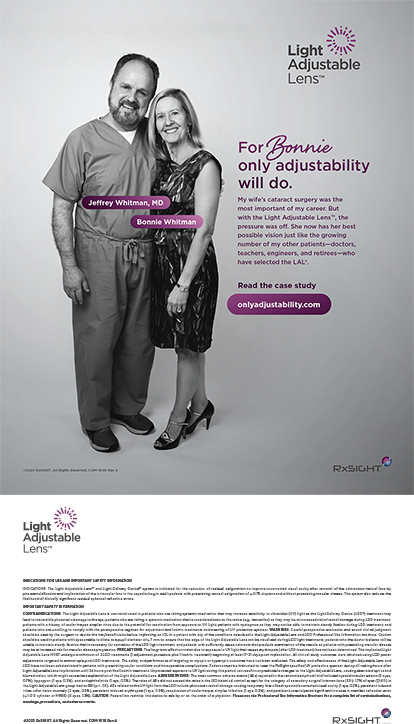Since first introduced to ophthalmic surgery in 1979, ophthalmic viscosurgical devices (OVDs) have helped surgeons maintain the anterior chamber and protect ocular tissue during cataract surgery. Injected prior to the capsulorhexis and then again during different phases of surgery, OVDs afford surgeons time and space during operations; in effect, they allow ophthalmologists of all skill levels to achieve excellent outcomes. In many respects, OVDs are the single most important tool in modern cataract surgery. What might the future hold?
THE CURRENT STATE OF THE ART
The two most notable OVD products introduced during the last few years are DisCoVisc (4% chondroitin sulphate-1.6% sodium hyaluronate; Alcon Laboratories, Fort Worth, TX) and Healon5 (2.3% sodium hyaluronate; Abbot Medical Optics Inc., Santa Ana, CA). Each has a unique set of biomechanical properties that combines many of the benefits of dispersive and cohesive agents.
Healon5 and Other Viscoadaptives
Similar to other viscous cohesive agents, including the original Healon (Abbott Medical Optics Inc.), viscoadaptives are highly viscous under low stress. In relatively static environments, the sodium hyaluronate polymer found in Healon5 has an even stronger resistance to flow (and is thus more viscous) than ProVisc (1.0% sodium hyaluronate; Alcon Laboratories, Inc.) or Healon (1.0% sodium hyaluronate). Under conditions of high fluid turbulence, however, the long chains of Healon5 fracture in a manner similar to that of a solid. This odd trait (also found in other viscoadaptives such as iVisc Phaco and BD MultiVisc [both manufactured by BD (Bidford-on-Avon, Warwickshire, United Kingdom)], neither available in the United States)1 has led some ophthalmologists to refer to viscoadaptives as pseudodispersives. The reason is that, as with dispersive OVDs, the removal of these agents from the anterior chamber requires higher flow and aspiration settings.
The high viscosity of Healon5 under conditions of low shear has prompted some researchers to suggest that it is the best option for preventing iris prolapse and thus is ideal in cases of intraoperative floppy iris syndrome (IFIS).2 Low aspiration and flow settings must be maintained, however, to retain Healon5 within the anterior chamber and avoid fracture of its rigid structure.3 Broken elements of sodium hyaluronate can easily escape the eye during surgery and expose the corneal endothelium and other vital ocular tissues to the damage associated with phaco energy and the chamber's collapse.
DisCoVisc
With moderate rheological properties, DisCoVisc resides in the middle ground of the cohesive/dispersive dichotomy. It simultaneously provides high viscosity and maintains space in the manner of Healon while protecting tissue like Viscoat (Alcon Laboratories, Inc.) and other dispersive OVDs. The intermediate nature of DisCoVisc makes it an acceptable solution for all phases of cataract surgeries.
The use of DisCoVisc has grown not only for routine phacoemulsification and IOL implantation but also for complex surgical situations. In cases of IFIS, DisCoVisc may be an effective alternative to Healon5.4 For these reasons, it is my preferred OVD for all stages of surgery, including the IOL's implantation.
WHAT LIES AHEAD FOR OVDs?
Manufacturing
While the latest wave of commercial OVDs has introduced novel and dynamic rheological properties into the OR, no single OVD is perfect for every surgical situation. Investigators continue to search for products that further aid surgeons in performing phacoemulsification and implanting IOLs as well as increasing patients' postoperative satisfaction.
Currently, the primary issue in the development of new OVD products is not whether there is a demand for improvement; with an aging patient pool at increased risk of complications, there certainly is. Rather, it is whether companies will be willing to spend the money and time to design new OVDs and bring them through the approval process and to market.
Viscoanesthesia
In the same way that the demand for innovation fuels the development of new OVDs, surgeons' ever-present desire to minimize the pain and discomfort of cataract surgery has led to the development of more specialized and effective anesthetics. One such example is the use of an anesthetic combined with a viscoelastic, known as viscoanesthesia. For example, Visthesia (Carl Zeiss Meditec AG, Jena, Germany), a product currently available in Europe but not the United States, combines 1.4% sodium hyaluronate with 1% lidocaine for injection into the anterior chamber during phacoemulsification and IOL implantation.
In a study of patients not under sedation, sodium hyaluronate 1.5% combined with lidocaine 1% resulted in significantly fewer incidences of pain during the IOL's implantation (1.8% of patients treated with a viscoanesthetic vs 15.6% with a viscoelastic alone), a burning sensation during the injection of acetylcholine (3.2% vs 24.6% patients), and pain during the placement of a corneal suture (17.4% vs 3.6% patients).5 The investigators also found no significant difference in edema between the groups on the following day.5 Likewise, prior research found lidocaine concentrations of 0.5%, 1.0%, and 1.65% to be safe for use in viscoanesthesia,6 with no significant effect on removal time following the IOL's implantation.7
Another investigation found significantly fewer cases of mild pain/discomfort (31.4%) among patients who received hydroxypropyl methylcellulose 2.25% combined with lidocaine 1% compared with hydroxypropyl methylcellulose alone (60.0%).8 The study, however, did not examine the possibly deleterious effects on ocular tissue.
Despite results suggesting that viscoanesthesia is a safe and effective alternative to topical anesthesia, other studies have found it to damage the endothelium. Perone and colleagues reported that viscoanesthetic containing 1% lidocaine caused a significantly greater loss of endothelial cells (20.3%) than viscoelastic alone (8.65%).9
Although viscoanesthetics appear to be an effective form of anesthetic drug delivery, concerns over their toxicity may dampen their influence on the future of OVDs in the US marketplace.
Breakdown Benefits
When a surgeon is unable to remove all remnants of an OVD from the anterior chamber after implanting an IOL, the residual viscoelastic can clog the trabecular meshwork and cause clinically significant IOP spikes.10 These can peak anytime from a half-hour to several hours after surgery, depending on the individual patient and the OVD used.10,11 Such transient postoperative rises can permanently damage the optic nerve, and they represent a persistent threat, not only to glaucoma patients, but also to glaucoma suspects and patients with a preoperatively normal IOP.
Of benefit would be the development of an OVD that could be broken down within the anterior chamber and would not need to be removed. One possibility is the postoperative injection of a compound that can break down the OVD. Varnell and colleagues found that injecting human hyaluronidase after the instillation of either Viscoat or Healon prevented a rise in IOP to a significant extent when the viscoelastic was not removed from rabbit eyes.12 Unfortunately, concerns about zonulysis hamper the benefits of this approach.
VISUAL AIDS
If enzymatic or other agents do not prove to be a viable or practical solution to postoperative IOP spikes, one possible alternative is an OVD color-coding system. Surgeons could more easily visualize tinted OVDs, which would facilitate their removal at the end of the operation.
Fluorescein sodium, indocyanine green, and trypan blue have all been used successfully to increase visualization of the anterior segment during surgery. In their "visco-shell" staining technique, Lim and Phillips showed that fluorescein could be used to make a homemade stain for enhanced visualization. A fluorescein strip mixed into 0.5 mL of balanced salt solution and then combined with a viscoelastic for a total volume of 1 mL was inserted via a 30-gauge irrigating cannula along the surface of the anterior capsule.13 Although this process increased visualization, the researchers warned that a protective layer of viscoelastic above the staining is necessary to avoid staining corneal endothelial cells.13 Likewise, Healon Yellow, an OVD that contained fluorescein dye, was once available in Japan but was withdrawn from the market due to staining of internal ocular structures.
Other concerns about viscostaining include the alteration of IOLs' biomechanical properties or the unintentional staining of the lens itself. A recent study by Dick and colleagues showed that cataract surgery enhanced by trypan blue caused stiffness and a reduction in the elasticity of the lens capsule.14 Jardeleza and colleagues also found that trypan blue increased capsular stiffness during the capsulorhexis.15 While an unwanted consequence in older adult patients, this phenomenon can actually aid the surgeon in performing a pediatric capsulorhexis.
CONCLUSION
With about 15 million cataract surgeries per year worldwide and a growing number of older patients at increased risk of complications, the demand for innovation in the design of OVDs is higher than ever. Although difficult economic times may make the developmental process seem like an expensive luxury, surgeons and patients are relying on continued breakthroughs in this often overlooked surgical tool.
Samuel Masket, MD, is a clinical professor of ophthalmology at the David Geffen School of Medicine, University of California, Los Angeles. He is a consultant to, is on the speaker's bureau of, and has received grants/research support from Alcon Laboratories, Inc. Dr. Masket may be reached at (310) 229-1220; avcmasket@aol.com.


